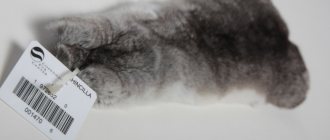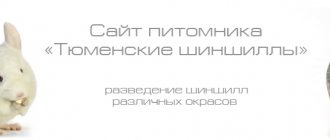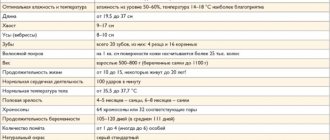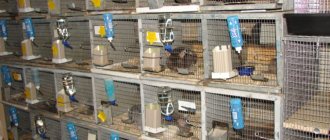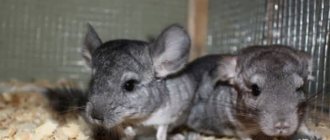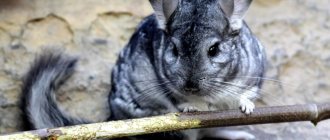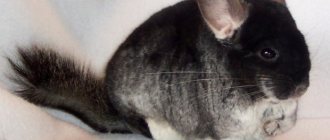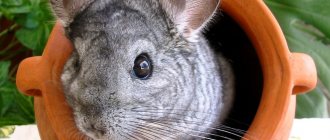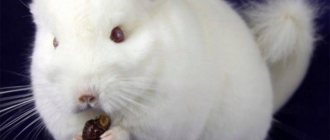- Rodents
| Data left by users (City, cost) | |
| Roslavl | 1000 |
| Pavlovo village Malyavino | 1000 |
| Novorossiysk | 1000-1500 |
| Tomsk (guys, don’t buy rabbits, buy them) | 6000 |
| Omsk | 1000 |
| Saransk | 500 |
Chinchillas are fluffy rodents with valuable fur, native to South America. We will talk about how much these animals cost in our article.
Chinchilla color
The main factor influencing the price is the color of the animal. The natural (standard) color of chinchillas is dark gray. A chinchilla of this color is highly valued if the back and sides have a rich dark color and there is a clearly defined border with a white belly.
The presence of stripes in color can raise the price even higher. But today, many colored chinchillas have been bred, they are bred from four main colors: standard, black velvet, white, beige. They cost an order of magnitude more than standard-colored animals. Because they are hatched in several stages and have a very complex genetic structure. Since their removal is associated with many difficulties and nuances. But when setting the price, many nuances are taken into account, here are the main ones:
- Uniform color in single-color chinchillas.
- The back and sides are uniform and rich in color.
- The back and sides are free of lightening and stains.
SILVER CHINS
SilverChins
- a peasant farm (peasant farm) engaged in the breeding and selection of fur chinchillas, as well as chinchillas of various color mutations for home keeping. Today we are one of the largest farms in Moscow and the Moscow region for breeding standard and colored chinchillas, with a total population of about 1000 animals.
We got our first chinchillas in 2008. Until 2013, we only bred chinchillas as pets. During this time, we encountered many difficulties in keeping and breeding chinchillas at home. We had to learn a lot from our own experience, through endless trial and error, and many experiments did not always end positively, and we got this invaluable experience at a fairly high price. Often the available information from books and Internet resources is not complete enough, and sometimes simply contradictory. On the pages of our website we will try to cover many questions regarding the keeping and breeding of chinchillas both on a farm and at home.
Since 2013, in addition to keeping, breeding and selling chinchillas, we have mastered several other related areas. Thus, we can safely classify ourselves as a full-cycle farm.
First direction
is the popularization of keeping chinchillas as a pet. We are ready to offer our customers a huge selection of multi-colored chinchillas for home keeping at affordable prices. Of the color mutations at the SilverChins farm, all dominant colors are represented, such as black velvet, white Wilson, beige Tower, blue slate, as well as various combinations thereof. In addition, we contain many recessive mutations such as Afro violet, Deutsch veilchen, german violet, sapphire, black pearl, royal persian angora and their variations . Our farm always has babies for sale of different colors, including fur standards, aged from 2 months to 1 year. If necessary, we can select adult chinchillas, or already formed pairs. You can come to us, look and choose the chinchilla you like (according to color, character, face, fur and other parameters that interest you). For colored chinchillas of our breeding, we issue a certificate of chinchilla origin (pedigree). We also provide our clients with ongoing advice on keeping and breeding chinchillas.
Second direction
— fur breeding of pedigree chinchillas. We are dedicated to breeding fur chinchillas of the highest standard. Our fur chinchillas were brought from a European farm and are qualitatively different from the usual home standards. We breed fur chinchillas not only of the gray standard color, but also fur chinchillas of several color mutations. For example, chinchillas of white-pink violet color have a pure white color with a cold tint and are ideally suited for sewing all kinds of wedding dresses and accessories. Chinchilla skins of homobeige violet have a cool, soft creamy hue; products made from such fur will not leave anyone indifferent.
Third direction
- fur dressing. We, like many beginning farmers in Russia who decided to connect their commercial activities with breeding chinchillas not as a pet, but as a fur-bearing animal, were faced with a huge problem in obtaining high-quality skins. Many Russian fur factories do not undertake the production of chinchilla fur. And those who do, as a rule, cannot obtain a semi-finished fur product that meets the standards that have developed over many years in the European fur market, since attempts to produce a chinchilla using a technology designed for rabbit fur does not give the desired result. The chinchilla dressing technology itself is somewhat different from traditional methods of producing fur raw materials. The dressing of chinchilla skins involves a lot of manual labor and is little automated, unlike the industrial dressing of other fur-bearing animals. Chinchilla fur is very delicate and requires extreme care during the dressing process. For large factories, moving away from existing technological processes is not profitable, and the amount of chinchilla skins offered for dressing is insignificant. All these factors determine that, at the moment, in Russia there is practically no place to get dressed chinchilla skins of decent quality. Beginning farmers, after searching and disappointment, have no choice but to smuggle raw materials for processing to Poland, Latvia, Hungary, or Denmark. This approach may still be justified in small farms, or at the initial stages of development, but as a business solution on an ongoing basis, it is clearly not suitable for a farm. It is for this reason that we decided to master the dressing of skins ourselves.
After almost a year of constant experimentation, we managed to solve this difficult problem thanks to close cooperation with a professional technologist in the field of fur dressing with 20 years of experience, who is also familiar with chinchilla fur. Thanks to this, today we have technology for chinchilla production that is not inferior in quality to European analogues.
Fourth direction
— feed production. We know firsthand all the difficulties of the food supply for chinchillas in Russia. During this time, we tried to feed our chinchillas with different foods, both Russian and foreign, and expensive and not so expensive, but each time more and more new circumstances occurred due to which it was impossible to feed this or that food. Together with enthusiastic breeders, we conducted comparative laboratory studies of all existing chinchilla feeds available on the market in Russia. We tried to study the issue of chinchilla nutrition as deeply as possible. After numerous experiments with the feed supply, as well as thanks to the consultations and assistance of specialists from the All-Russian Research Institute of Feeds named after V.R. Williams" and "Institute of Fur Farming and Rabbit Breeding named after V.A. Afanasyev”, we have developed 3 types of complete balanced food, taking into account the physiology and maintenance of various groups of chinchillas. At the same time, we purchased and set up a mini feed mill, where we extrude grain crops and produce granules for our farm.
And the fifth direction
— production of cells and components for them. We have come all the way from keeping and breeding chinchillas at home to a full-fledged chinchilla farm. That’s why we had cells from glass display cases for a monogamous family 1+1, to production polygamous cells for a family 1+4. Based on our accumulated experience, we are always ready to give advice on which types of cells will be preferable in each specific case. We have equipment for both wood and metal work. According to your orders, we are ready to produce almost any cages, feeders, bathing boxes, kennels, trays, shelves and door locks.
SilverChins
What to consider if you want to get a chinchilla
If you decide to purchase a chinchilla as a family pet, then the purity of its breed, the size of its ears and eyes, and its other external characteristics are unlikely to play a big role for you. If you are faced with a choice: a boy or a girl, then this does not really matter, because, regardless of gender, chinchillas are very calm and balanced animals . Of course, each animal is endowed with its own individuality, and has its own temperament and character.
A chinchilla can live alone in a cage; it tolerates loneliness normally. But in this case, she will demand the attention of her owners. The chinchilla is an intelligent animal that can be trained a little. You can easily teach her to take food from your hands, stroke her neck and belly, and she can sit in your arms. A chinchilla definitely needs to be “educated” if you don’t want to end up with an uncontrollable and impudent animal. When the animal gets used to you, you can let it out for a while to walk around the room. But do not leave him alone unattended, as they pay increased attention to wires, slippers and other things that are “interesting” to them.
Fur
Chinchillas are loved for their beautiful fur, so the value of the animal depends on its condition. It should be slightly shiny in appearance, clean, and free of any lumps or dirt. If a chinchilla looks dirty, it means it is poorly cared for or is sick with something.
The animal's fur should be:
- Thick. Blow on the chinchilla or push the fur away with your hands; if no skin is visible, the fur is very thick.
- Short. Long fur is more common, but it is not valued.
- Brilliant. A healthy chinchilla's fur is always slightly shiny.
- Elastic. Blow on the chinchilla, the fur should return to its normal position.
My farm is still thriving today.
Today my business does not stand still. It moves in the right direction and only goes up. Now I have 400 adult chinchillas. I sell only 600 puppies to my sister for 3,000 rubles each and found another sales place in Omsk, where I sell puppies for 4,000 rubles each.
Now my annual earnings are 4,200,000. If we divide this earnings by 12 months, then my monthly salary is 350,000.
Chinchilla farm.
Some businessmen earn more, but I am a businesswoman who never aspired to have millions, but it just happened that way.
Also read: One eco-fur coat saves 200 chinchillas, or beauty does not always require sacrifice.
Let's calculate my income
In total, I spent 800,000 rubles on opening and developing the business. I have been in my business for 10 years and have fully returned the money.
I have been receiving an income of 2,650,000 per year for 10 years. That is, I have already earned 26,500,000 rubles on my farm. From this money we subtract the funds spent in the amount of 1,000,000 rubles. The result is an exhaust amount of 25,500,000 rubles.
As I said, having worked on my farm for 10 years, I have never regretted it and I am very happy with my earnings. I'm thinking about increasing the price of puppies to 4,000 per puppy. Chinchillas have different prices in different areas; you can sell them where they are more expensive. The price for three-month-old chinchillas ranges from 3,000 to 5,000 rubles. You just need to find a place to sell and make a good profit.
Conditions of detention, business plan, profitability
In nature, you can only find chinchillas with a gray color.
But over the past hundred years, with the help of genetic engineering, specialists have managed to breed chinchillas with purple, beige, white and other colors. Article navigation
- Brief overview of the market
- What you need to know about chinchillas
- Food for chinchillas and necessary equipment
- Chinchilla cages
- Room
- Registering a business, drawing up a business plan
- Chinchilla breeding business
- Sales of chinchilla skins
- Nuances and tips
In this article we will analyze the organization of a small chinchilla farm. Starting investment – from 600 to 900 thousand rubles (depending on the number of animals and a number of other conditions). If desired, this business can be easily scaled by increasing the livestock depending on demand. Key questions: “How difficult is it?” and “Is breeding chinchillas profitable in modern conditions?” These are the ones we will answer first.
Floor
Everything is simple here. Females are valued and almost everyone is eager to adopt them if they are a professional breeder. Oddly enough, there are usually more boys born, so there is no shortage of them.
Males are not yet so valued because chinchillas are polygamous animals. You can keep just 1 male for several females and you will not have any problems with reproduction.
If you plan to buy only 1 animal for your home, then it is better to take a male, since its maintenance is no different from a female, and it costs at least 1.5 times less.
physical characteristics
In addition to fur and color, the proportions of a chinchilla's body are very important. The most valuable animals are those with the following characteristics:
- Correct body proportions; the animal should have approximately the same distance between the shoulders and the sacrum.
- The head should be quite wide, and not narrow like that of rats. This face looks much more beautiful.
- Beautiful, wide and shiny eyes.
- Short, not elongated neck.
- The weight of an adult should be about 600-800 grams.
- The ears should be round in shape, this is easy to determine visually.

